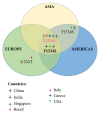Insecticide Resistance Associated with kdr Mutations in Aedes albopictus: An Update on Worldwide Evidences
- PMID: 30175124
- PMCID: PMC6098900
- DOI: 10.1155/2018/3098575
Insecticide Resistance Associated with kdr Mutations in Aedes albopictus: An Update on Worldwide Evidences
Abstract
Insecticide resistance is an increasing problem worldwide that limits the efficacy of control methods against several pests of health interest. Among them, Aedes albopictus mosquitoes are efficient vectors of relevant pathogens causing animal and human diseases worldwide, including yellow fever, chikungunya, dengue, and Zika. Different mechanisms are associated in conferring resistance to chemical insecticides. One of the most widespread and analysed mechanisms is the knockdown resistance (kdr) causing resistance to DDT and pyrethroids. The mechanism is associated with mutations in the voltage sensitive sodium channel, which is involved in beginning and propagation of action potentials in nervous cells. The mechanism was originally discovered in the housefly and then it was found in a large number of arthropods. In 2011, a kdr associated mutation was evidenced for the first time in A. albopictus and afterward several evidences were reported in the different areas of the world, including China, USA, Brazil, India, and Mediterranean Countries. This review aims to update and summarize current evidences on kdr in A. albopictus, in order to stimulate further researches to analyse in depth A. albopictus resistance status across the world, especially in countries where the presence of this vector is still an emerging issue. Such information is currently needed given the well-known vector role of A. albopictus in the transmission of severe infectious diseases. Furthermore, the widespread use of chemical insecticides for control strategies against A. albopictus progressively lead to pressure selection inducing the rise of insecticide resistance-related mutations in the species. Such event is especially evident in some countries as China, often related to a history of uncontrolled use of chemical insecticides. Thus, a careful picture on the diffusion of kdr mutations worldwide represents a milestone for the implementation of control plans and the triggering of novel research on alternative strategies for mosquito-borne infections.
Figures


References
-
- Hawley W. A. The Biology of Aedes albopictus. Journal of the American Mosquito Control Association. 1988;1:1–39. - PubMed
Publication types
MeSH terms
Substances
LinkOut - more resources
Full Text Sources
Other Literature Sources
Miscellaneous

